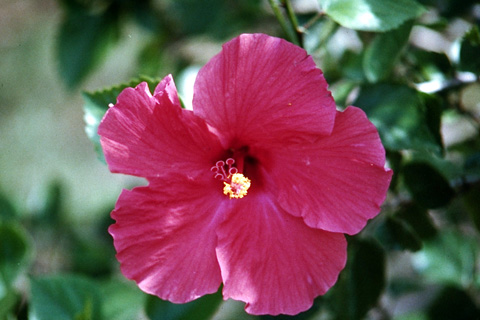Adaptations
 The
Hibiscus rosa-sinensis has developed many adaptations
for its environment. One of the main adaptations of the
Hibiscus rosa-sinensis
would be that, it does not move at all due to the fact that it contains a
cell wall made of cellulose.
The
Hibiscus rosa-sinensis has developed many adaptations
for its environment. One of the main adaptations of the
Hibiscus rosa-sinensis
would be that, it does not move at all due to the fact that it contains a
cell wall made of cellulose.
The Hibiscus rosa- sinensis grows in a tropical to sub-tropical regions, which makes the flowers really tender to frost. The plant will die off if it is exposed to temperatures that are less than 55 degrees Fahrenheit. If the plant is grown in regions that reach temperatures that are below 55 degrees Fahrenheit the plant must be brought in as a houseplant or else the perennial plant becomes an annual. This adaptation is due to the plant’s habitat.
The plant needs to be watered frequently,
but if it is over watered the plant may die off. The need to
have a lot of water is due to the plant living in tropical areas
that receive a vast amount of rainfall yearly. The leaves of the
Hibiscus rosa- sinensis turn yellow when there is not
enough nitrogen in the soil. This adaptation also may also
because by the plant’s habitat.
 The nitrogen cycle plays a large
role into whether the plant receives enough nitrogen. Without
enough water it is difficult for the plant to receive nitrogen
other than what is in the atmosphere. Also without enough water
it is difficult for the plant to partake in photosynthesis.
The nitrogen cycle plays a large
role into whether the plant receives enough nitrogen. Without
enough water it is difficult for the plant to receive nitrogen
other than what is in the atmosphere. Also without enough water
it is difficult for the plant to partake in photosynthesis.
The Hibiscus rosa- sinensis attracts many humming birds and butterflies. This is probably because of their brightly color flowers. Hibiscus rosa-sinensis plants cannot handle too much humidity or fluctuations in temperatures. If the temperature is too cool the plant may not flower at all. The plant however, does require a lot of sunlight to grow. Areas that do not contain a lot of sunlight will also affect the plant’s ability to flower and grow. Extreme variations in sunlight, may as well affect the plant’s ability to grow.
Click here to return home!
Click here to visit the nutrition page!